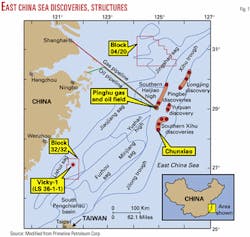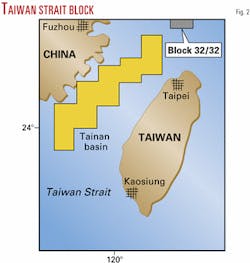China's Offshore Revival: Exploration, development to pick up in frontier basins off eastern China
China plans to step up exploration in frontier basins off its East Coast as part of its drive to establish an integrated gas industry in some of its most populous areas.
Large volumes of gas for consumption in eastern China are expected to originate as far west as the Tarim basin in Xinjiang Uygur Autonomous Region in far northwestern China. Supplementing this will be gas supplies from the East China Sea, imported liquefied natural gas, and possibly the Taiwan Strait.
Exploration is in a stage of infancy. Only one field has been placed on production in these frontier areas, that being Pinghu gas and oil field in the East China Sea (Fig. 1).
China National Offshore Oil Corp. and its operating entity, CNOOC Ltd., and its licensees have concentrated on oil development in China's two premier offshore producing areas, the South China Sea and Bohai Bay.
CNOOC hoped to market gas from the eastern basins in several provinces, including Fujian. CNOOC and the provincial government said they are committed to sourcing gas from all viable sources, including offshore exploration and overseas.
CNOOC claimed net proved reserves of 1.8 billion boe and net production of 239,337 boe/d as of Dec. 31, 2000. It held interests in 45 crude oil and natural gas properties in Bohai Bay, the western and eastern South China Sea, and the East China Sea.
East China Sea
CNOOC has described big plans to ramp up exploration in the East China Sea, but progress can be painfully slow.
China licensed 20 blocks covering 72,800 sq km in the East China Sea for foreign participation in 1992. Ten foreign companies including Texaco, Shell, Cluff, and Phillips signed 18 PSCs for the blocks. In the end, they drilled 14 dry holes.
Nevertheless, CNOOC said it expects the area to become an important gas producing base in the future.
Pinghu gas and oil field in the East China Sea is the only producing property off eastern China outside Bohai Bay and the South China Sea.
Discovered in 1992, Pinghu began producing crude oil in November 1998 and gas and condensate in April 1999. The field covers 240 sq km in 287 ft of water.
Pinghu has reserves of 10.8 billion cu m of gas, 13 million bbl of condensate, and 79 million bbl of light crude to be produced.
The field is under joint ownership of the Shanghai Municipal Government (Shanghai Oil & Gas Corp.) 40%, Sinopec Star Oil & Gas Co. Ltd. 30%, and CNOOC 30% of the 5.1 billion yuan total investment.
Pinghu produced 260 million cu m of gas in 2000, still below its design capacity of 486 million cu m/year.
From the platform on the continental shelf, gas is piped about 400 km to Shanghai, where the gas is consumed in power generation, domestic uses, and the chemical sector. Oil and condensate are piped almost the same distance to Ningbo.
Initially, Pinghu production was to continue for 10-15 years. China had made public a plan earlier this year to double Pinghu's gas production to 71-78 MMcfd by 2003 and double reserves, which would markedly extend field life.
Xihu trough exploitation
CNOOC Ltd. said it was to start talks in late 2001 with units of Royal Dutch/Shell and Unocal Corp. in regard to joint exploration of the Xihu trough in the East China Sea.
CNOOC, which is the only designated operator for exploration and production in Xihu trough, plans to drill four to six exploration wells in 2002 at a cost of $200 million as part of a total budget of $1.5 billion.
Xihu has 300 billion cu m of probable natural gas reserves.
CNOOC said that Shell has the option to participate because of its strategic partnership with CNOOC and Sinopec Corp. subsidiary China Petroleum & Chemical Corp., and that Unocal has conducted a geological survey in the East China Sea with Sinopec unit Sinopec Star Petroleum E&P Co.
Shell signed the strategic alliance in late 2000. It covered exploration, development, and production of gas in the Xihu trough, exploration and joint development and production of oil and gas fields on the Bonan Block in Bohai Gulf, and joint natural gas development in Shandong, Anhui, Henan, Jiangsu, Shanghai, Fujian, and Zhejiang in eastern China.
CNOOC was taking the first steps earlier this year to develop fields on the Chunxiao structure, which was to supply gas to Zhejiang Province.
Chunxiao lies in the Xihu trough 80 km southeast of Pinghu field. Chunxiao field itself is the southernmost of the finds labeled "Southern Xihu discoveries" (Fig. 1). CNOOC said it had verified gas reserves of 1.9 tcf in the Chunxiao area alone.
CNOOC announced plans to start production from Chunxiao by 2004. Production was to be 71 bcf the first year and 282-353 bcf/year by 2010. It did not announce the development scheme or whether it would involve use of the gas pipeline already operating between Pinghu field and Shanghai.
Another of the Chunxiao area discoveries is Tianwaitian, which was under appraisal in 2001. Tianwaitian-3 flowed 24 MMcfd of gas and 175 b/d of condensate. It was drilled to 3,760 m MD and found more than 10 gas pay zones.
The Tianwaitian-1 discovery well, drilled to 5,000 m in 1986 by an oil crew supervised by the Ministry of Geology and Mineral Resources, is the deepest exploration well off China.
Vicky discovery
Another undeveloped accumulation in the southwestern East China Sea is Lishui 36-1-1, or Vicky.
Primeline Petroleum Corp., London, won Block 32/32 in 1994 and made the Vicky discovery in 1997. The discovery well, in 90 m of water 100 km offshore, flowed almost 10 MMcfd of gas, 117 b/d of condensate, and 15.7 b/d of water from 33 m of Paleocene Lingfeng sands and shales at about 2,250 m.
The gas at Vicky analyzed 55% methane and 34.5% carbon dioxide. A well drilled by the Chinese in 1985 about 30 km southwest of Vicky flowed more than 90% CO2 from the Lingfeng formation.
Primeline acquired 3D seismic data over the discovery and formulated plans for its appraisal and for potential gas marketing to the city of Wenzhou. Studies indicated that substantial gas prices would have been needed to justify development because of the deposit's relatively small size.
In mid-2000 Primeline agreed to transfer its stake to CNOOC. That left Primeline with a 15% interest. Primeline had estimated Vicky reserves at a most likely 705 bcf of gas and 8 million bbl of condensate.
Taiwan Strait
Taiwan has made several attempts to explore nearshore portions of the strait to its west during the past decade.
Taiwan in early November revoked a ban on direct trade and investment in Mainland China that had been in effect since 1949. Taiwan businesses had found ways around the former restrictions. The revocation was seen as symbolic of a relaxation in economic curbs, but it also preceded parliamentary and mayoral elections in early December.
Press reports in late 2001 said CNOOC and Taiwan's Chinese Petroleum Corp. were close to signing a final agreement to explore the Taiwan Strait.
The agreement involves the Tainan basin. The two companies jointly ran geophysical surveys in 1999 and reported structures worthy of evaluation. They signed a preliminary agreement in 1996, and Taipei ratified the agreement in 1998.
CPC is soon to process data acquired jointly with CNOOC since 1996 on the Tainan-Chaoshan block. The companies were to decide by yearend 2001 if the block has enough prospectivity to warrant wildcat drilling.
The block to be explored covers almost 6,000 sq miles between Taiwan and Guandong and Fujian provinces (Fig. 2). Taiwanese press reports described the area as lying southeast of the Zhu Jiang river estuary, which is in Guangdong Province. The distance between Taiwan and Mainland China is 80 miles at its closest point.
Meanwhile, CPC's Taiwan Petroleum Exploration Division reported 69 onshore wells on production and averaging a combined 70 MMcfd of gas at yearend 2000. Almost all of the fields are in the western plains and foothills belt.
CPC has drilled 132 offshore wells since starting exploration in December 1972. The CBK structure 25 km off Hsinchu on Taiwan's northwestern coast produced gas from 1986-2000, and positive shows were reported near Kaohsiung, Keelung, Penghu, Lukang, and Hsinchu.
More recently CPC has explored the CFS structure in the Tainan basin off Kaohsiung, where it has drilled several wells with shows.
Conoco Inc. found gas off Kaohsiung in 1971 but relinquished the block to CPC because it was looking for oil. Conoco and CPC agreed to jointly explore large areas off western and northern Taiwan in 1996 against the backdrop of increasing military tension, but this program was never carried out (see map, OGJ, Mar. 25, 1996, p. 34).




